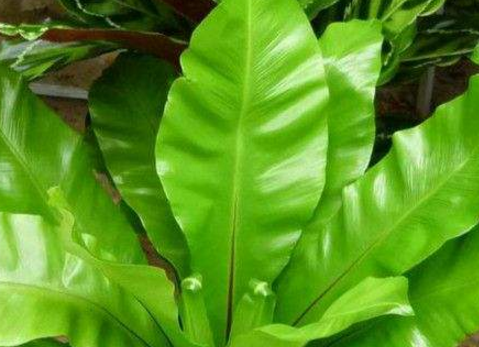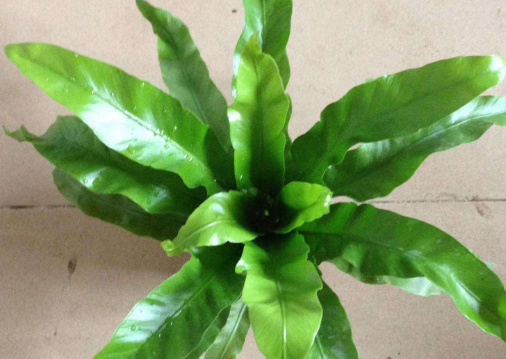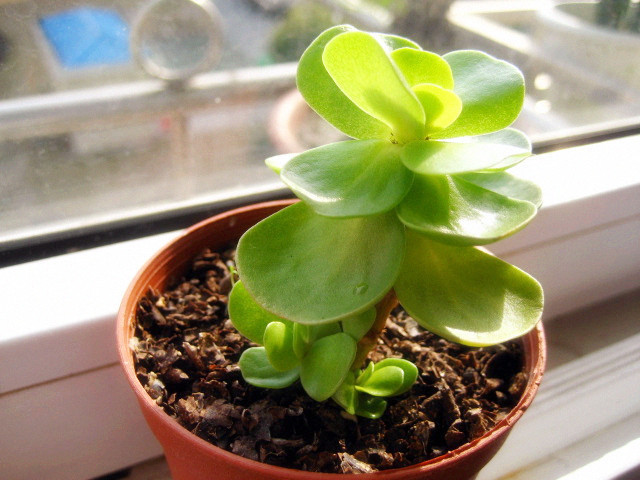Breeding method of nest fern
Spore reproduction
When spring comes, disinfect the prepared sowing with the soil, then put it into the basin, then sprinkle the mature spores evenly on the basin soil, then soak the whole basin into water, let the basin soil fully wet, cover the glass basin to moisturize, and finally put it in a cool place. After about a week, new buds can sprout, green protoleaves can grow after a month, and several true leaves can grow after 3 months, so that they can be cultivated in the basin.

Ramet propagation
In late spring and early summer, new buds are about to grow, choose relatively strong new buds, carefully cut the plant parts that need to be separated with a knife, cut into 2-4 pieces, and cut the leaves short by about 1/3, each with part of the leaves and rhizomes, and finally put them into pots to cultivate them, making them called independent plants. Place the basin in the semi-shade where the temperature is above 20 °C to help the wound heal as soon as possible.
Do you know the breeding method of bird's nest fern? You can try it.
The breeding method of bird's nest fern usually uses the method of spore sowing and plant division. In March or July to August, scrape the mature spores from the leaves (the spores of bird nest ferns can be seen in the picture), use 2 portions of rotten leaf soil and 1 part of fine sand to mix the matrix, put them into a small flowerpot to smooth and compaction, put them in shallow water after disinfection, spread spores evenly, and cover with glass slides to moisturize. Under 24 ℃ light for 12 hours a day, the light intensity 3000Lx, about 6-8 days after spore germination, 2 months later, the prothallus and archegonia mature, at this time pay attention to spray water to create conditions for fertilization. A large number of young sporophytes will be produced soon and can be transplanted when 3-4 leaves are grown. The branch propagation of http://www.yuhuagu.com bird's nest fern can not be done by the method of ion plant because there are few branches. Ramet propagation is simple and easy, but it is easy to damage the plant shape and recover slowly. The robust plant can be cut into 4 pieces from the basal part in the middle and last ten days of April, and the leaves can be cut short by 1, 3, 1 and 2, so that each piece has partial leaves and rhizomes, and can be potted separately to become a new plant. After pot planting, put it in a place with a temperature above 20 ℃, semi-overcast and high air humidity to make the wound heal as soon as possible. The cultivation material in the basin is slightly moist, not too wet, otherwise it is easy to rot, and the original shape can be gradually restored after the new leaves grow out. How to raise bird's nest fern and teach you the method of breeding bird's nest fern
Bird's nest fern is named bird's nest fern because its leaves are radiating around the short rhizome, hollow as a bird's nest. How to raise the bird's nest fern? What is the breeding method of bird's nest fern? The following editor will give you a detailed introduction, let's take a look.
1. Brief introduction of bird's nest fern
Bird's nest fern, also known as nest fern, Chaoshan Suhua, Shansu flower, crown fern, seven-star sword, bird nest fern, sharp knife Ruyi San, eagle seven, etc., is a kind of epiphytic fern, native to eastern Australia, Indonesia, eastern Asia and other places, the plant height is 100-120 cm. Bird's nest ferns are attached to tree trunks, rocks and other places, and the base accumulates the fallen leaves of many other tree species in the shape of a bird's nest, hence the name. The rhizome of the bird's nest fern is short and thick, and the marginal leaves are clustered from the underground stems and are nesting from the central direction. Bird's nest ferns like high temperatures and are not resistant to strong light, and especially like to attach to tree trunks or rocks in the jade forest or the seasonal rain forest.
Second, how to raise bird's nest ferns?
Bird's nest fern likes warm and humid environment, can not bear high temperature and cold, and should spray more water and more ventilation when it is higher than 30 ℃. Bird's nest fern likes high humid environment and is not resistant to dryness. Frequent water spraying increases air humidity. The bird's nest fern is more shade-tolerant, but it also needs scattered light to grow better. Don't put the bird's nest fern in a place without light for a long time, and prevent exposure when the sun is strong. Under the condition of high temperature and humidity in summer, it is necessary to spray more water and fully spray the foliar surface to maintain a higher air temperature, which is beneficial to the culture of bird nest fern. With the increase of the leaves of the bird nest fern, the leaves are often covered with the culture soil in the basin, and the watering basin must be thoroughly watered in order to avoid the dry and curl of the bird nest fern leaves due to lack of water.
3. The culture method of bird's nest fern
1. Reproduction: the breeding method of bird's nest fern can be sowed and propagated separately. The method of ramet propagation is generally adopted. Before the new buds are born in late spring and early summer, slowly cut off the plants that need to be separated with a sharp knife, and then plant them separately.
2. Planting: the nest fern is planted for 2-3 years, the plant shape is open, and the root is full of pot rack, which can be removed from the basin, some of the residual roots and the spore leaves withered at the base are removed, taken out in the plant, and replanted in the pot. When changing the basin in spring, rotten leaf soil and moss should be added to the basin, and a little gravel should be added.
3. Lighting: after planting, bird's nest ferns should be kept in the courtyard under the shade of about 50% of the sun. The direction of the flowerpot should be turned once every 5-7 days, so that the plant receives light evenly and each part develops evenly, so as to promote the growth of bird nest fern. Summer should be shaded or cultured in a sparse shade under a big tree to avoid strong direct sunlight, which is conducive to the growth of bird's nest ferns and makes the leaves shiny. In the indoor should be put in the bright light of the place breeding, can not be in the dark for a long time.
4. Temperature: the suitable temperature for the growth of bird's nest fern is 22-27 ℃. In winter, the bird's nest fern can be placed in the greenhouse or sunny place in the room, the temperature can be kept above 16 ℃, so that the bird's nest fern can continue to grow, but the lowest temperature can not be lower than 5 ℃. The indoor temperature should be above 20 ℃ in the daytime and 15 ℃ in the night. When the temperature is low, the bird nest fern stops growing.
5. Soil: mountain mud and pond mud mixed with appropriate amount of wood chips are commonly used as culture medium for bird's nest fern pot cultivation, and a little base fertilizer is added. Bean cake can be used as base fertilizer, and fern root, moss or broken bark can be used as pot material if possible.
6. Watering: bird's nest ferns have strict requirements for water, often check the situation of water and fertilizer, often water to keep the basin soil moist, and spray water to the leaves and around them several times a day to maintain a relative humidity of more than 80%. But do not accumulate water in the basin, otherwise the bird's nest fern is easy to rot and die.
7. Fertilization: fertilizer is applied every 20 days or so in the growing season of bird's nest fern, usually 4-6 times a year. The temperature between 15 and 26 ℃ can irrigate thin fertilizer and water, which is very beneficial to the growth of bird's nest fern.
8. Pruning: the bird nest fern needs to cut off the withered branches and leaves in time to keep the bird nest fern plant shape beautiful.
IV. matters needing attention in the culture of bird's nest fern
1. Bird's nest fern likes water, so the basin soil would rather be wet than dry. It is necessary to keep a certain amount of moisture, and do not set a fixed watering time.
2. Under the condition of high temperature and humidity in summer, the growth of new leaves needs more water, and keeping the humidity of the air is beneficial to the germination of spores.
3. The breeding of bird's nest fern does not need too much sunshine, just the right amount.
4. The growing season of bird's nest fern should be fully watered, and the basin soil should be kept moist when the room temperature is low in winter. Watering can be done frequently when the temperature is high, every day or every other day, and once every 3-5 days under low temperature conditions.
- Prev

Maintenance methods of bird's nest fern
1. Water spring and summer is the bird's nest fern growth peak period, at this time to more watering, but also often spray water to the leaf surface, so that the leaf surface neat. And keep the humidity 70%, 80%, do not leave stagnant water, otherwise there will be rotten roots. two。 When the ramet pruning bird's nest fern grows to be very dense, it will produce small branches.
- Next

The cause of yellowing and softening of leaves
The sun shines on a hot summer day, the sun shines directly, the soil moisture is missing, and the direct sunlight causes the tender leaves to be burned, and then the phenomenon of yellowing and softening occurs. Prevention and control measures: do not let the money wood suddenly accept the sun exposure, can give appropriate light
Related
- Fuxing push coffee new agricultural production and marketing class: lack of small-scale processing plants
- Jujube rice field leisure farm deep ploughing Yilan for five years to create a space for organic food and play
- Nongyu Farm-A trial of organic papaya for brave women with advanced technology
- Four points for attention in the prevention and control of diseases and insect pests of edible fungi
- How to add nutrient solution to Edible Fungi
- Is there any good way to control edible fungus mites?
- Open Inoculation Technology of Edible Fungi
- Is there any clever way to use fertilizer for edible fungus in winter?
- What agents are used to kill the pathogens of edible fungi in the mushroom shed?
- Rapid drying of Edible Fungi

